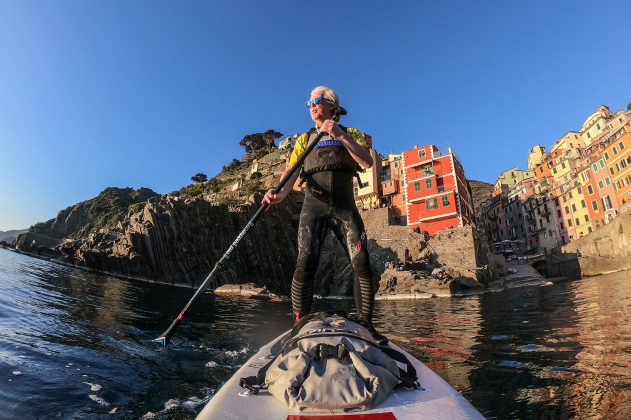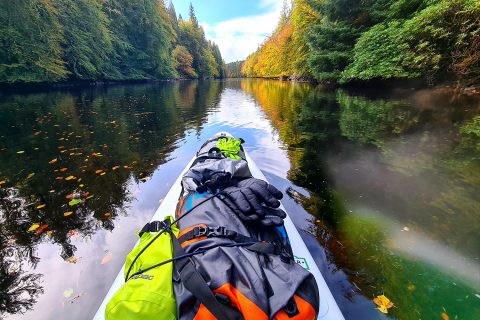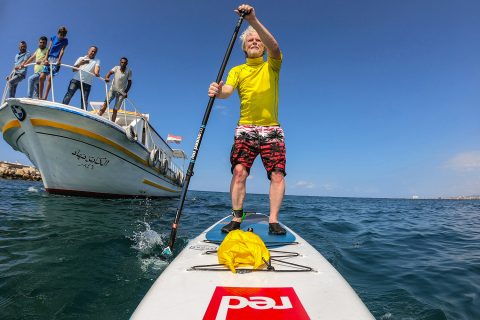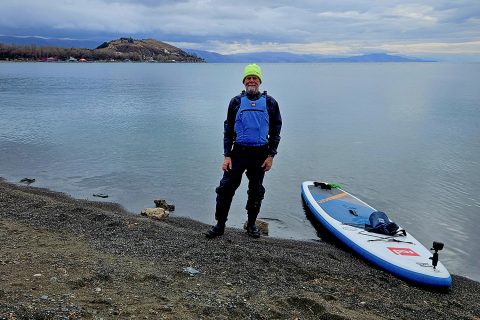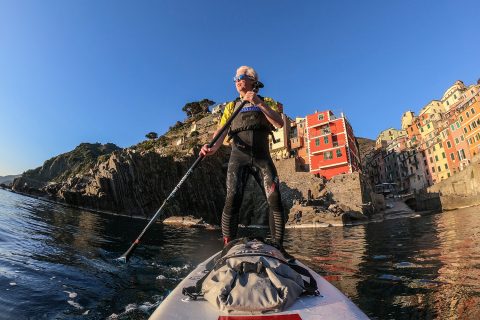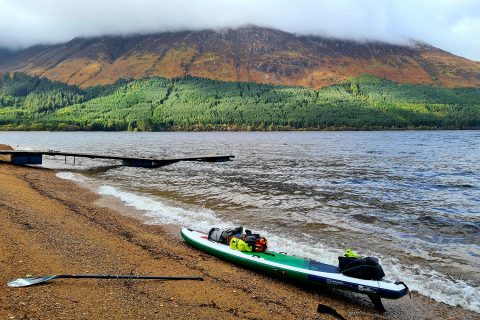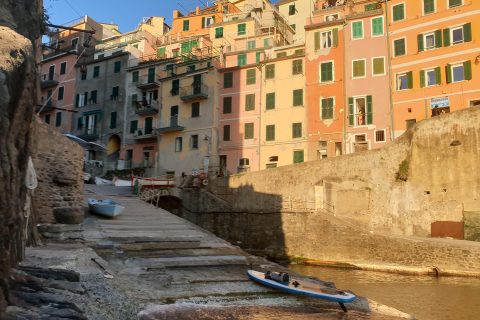SUP THE WORLD: JOHN MCFADZEAN
Since his first SUP lesson on a local lake in June 2014, John McFadzean has stand-up paddled in 52 countries worldwide. Here are some of his highlights:
Words and photos: John McFadzean
SUP the Five Lands
This 2019 trip was one of my first big SUP adventures – a solo one-day trip along the Italian coast at Cinque Terre (translation: Five Lands). Setting off from the sandy beach at Levanto on flat early morning waters, I was eager to visit each of the five picturesque, multi-coloured seaside villages that make up the UNESCO World Heritage Site of Cinque Terre.
An hour or so in, my first stop was at the northernmost village, Monterosso al Mare, where I grabbed a cappuccino and croissant for breakfast. A few kilometres later, it was lunchtime. Leaving my board in the harbour at Vernazza, I climbed a few steps to a tiny plaza, found an empty table, and treated myself to a large bowl of pasta and a small glass of wine.
After lunch, the wind picked up, and I had to battle bumpy sea conditions. I didn’t stop at the middle village, Corniglia, as it sits atop a cliff, and I wanted to preserve my energy for paddling (translation: I was being lazy). Later, conditions improved somewhat, and I was delighted to reach my penultimate stop at Manarola and enjoy an afternoon gelato in the warm Italian sunshine. When I reached Riomaggiore, the southernmost village, the sun was setting behind me over the Ligurian Sea and the surrounding area was bathed in a vivid orange hue. Even the sea seemed to be orange. The wind had vanished, and the water was flat once more. Hours earlier, I had been desperate for my journey to end. Now, I was sad to go ashore. But it was time to finish, to enjoy a pizza and a large glass of Chianti to celebrate a successful day.
It took me all day to paddle the 20 kilometres from Levanto to Riomaggiore and 30 minutes back on the train.
Bizarre moments
In June 2019, I was somewhere in the Finnish wilderness, wild camping on the bank of the River Torne, which marks the border between Finland and Sweden. It was a remote spot, well and truly inside the Arctic Circle, the land of the midnight sun, miles from civilisation, with no other human beings in sight. I considered paddling on the river, but it was fast-flowing and dangerous. Sharp rocks were jutting through the surface, being pounded by whitewater. Even if I survived the journey, I knew I could paddle in one direction only – downstream. But, overnighting in the middle of nowhere, I felt like a brave explorer, a stand-up paddleboarding version of Sir Edmund Hillary or Neil Armstrong. I was a hero – the most heroic hero since the invention of heroism. I shuddered, and the hair stood on the back of my neck as a wave of pride ran through my brave explorer’s body. At that very moment, I heard a ‘boom, boom, boom’ sound from upstream.
‘What on earth is that?’ I thought.
‘I’m in the wilds of Finland. Surely there is no one else here.’
The film Deliverance came frighteningly to mind, and I half expected to hear banjos. Then, from around a river bend, came the most unexpected sight – a giant inflatable pink flamingo, three people onboard wearing regular clothes and holding paddles, some dreadful Europop blaring from a beatbox on board. Perhaps I wasn’t quite in the wilderness after all.
Autumn 2021 saw me wild camping again, this time on the isolated eastern shore of Loch Morar in Scotland. On this occasion, I was definitely far away from the nearest other people. The grunting deer and the howling wind were my only companions. Once I had put my tent up and cooked dinner, it was pitch dark, even though it was still early evening. It was too early to sleep, but I had no desire to venture out of my snug tent. What to do ’til bedtime? I had not brought any reading material, and the closest mobile phone signal was far, far away. What to do? I had brought the family tablet as a backup in case I lost or damaged my phone. And although I had never watched any movies on it, I recalled that my two youngest daughters had saved a number of their favourites to the device. That is how I became the only person ever to spend a cold, dark evening on the desolate, windswept shores of Loch Morar watching Horrid Henry: The Movie.
Encounters with the army
My first brush with the military came in 2018 when I explored Transnistria in Eastern Europe. Technically part of Moldova, this tiny slither of land lies to the east of that country, right up against the border with Ukraine. There was a brief civil war here in the 1990s before the ethnic Russian community unilaterally declared independence. No other governments recognise Transnistria.
My task was to paddle between the two largest cities, Bender and Tiraspol, along the Dniester River. Soon after setting off from Bender, I cruised past a rusty, seemingly abandoned derelict boat. But as I passed, an armed man wearing army-style camouflage appeared on deck. He yelled and angrily gestured for me to move away. Fortunately, I don’t speak Russian, so I had no idea what he was shouting. I kept paddling with my head down, hoping not to be shot. To this day, I have no idea what that vessel was or why it was apparently off-limits to a humble SUP boarder.
My second encounter with the army was less scary, but equally nerve-wracking. For many years, my stated intention to paddle in every country in the world was met with questions such as ‘What about Syria?’ and references to other seemingly dangerous places. Well, I hate being told I can’t do something. That’s why I found myself in Syria in October 2019, being interviewed by an army officer, praying that he would allow me to stand-up paddle at the island of Arwad. It was a friendly meeting, but I was on tenterhooks until he made his decision. Generally speaking, I believe it’s better to ask for forgiveness than permission, but not in this case. To my relief, he said yes.
In November 2023, I paddled out from the Armenian town of Sevan on the northwestern shore of the lake of the same name. A headland lay to my left, with a large villa near the point. I fancied going past the house and around the tip to see what was on the other side. As I approached, I saw that the villa lay behind a high fence, and as I got closer, two unsmiling soldiers in full uniform came from a sentry box and walked assertively towards me. They shouted something, and when it was clear that I didn’t understand, the taller of the two made a turning signal with his hand. I repeated the gesture and nodded as I turned back. They were both armed, so I wasn’t inclined to argue the point. I later found out they were guarding the summer residence of the country’s president.
Scariest moment
Although these army encounters were concerning, I was never really frightened. My scariest moment came from a foolish mistake I made on the River Danube at the border between Germany and Austria. In preparation for my multi-day trip from Passau in Germany, through Austria to the Slovakian capital of Bratislava, I had carefully researched all the hydroelectric dams on the route. I knew how many kilometres it was to the next dam and on which side of the river to find the portage egress. It all went terribly, almost fatally, wrong at the very first dam, Jochenstein. My plan instructed me to exit the river on the right-hand side, but at the very last minute, I decided it looked wrong. A nagging internal voice was telling me the portage was on the opposite side. With the benefit of hindsight, I should have simply stopped for a moment and calmly looked at my notes. But I didn’t. I responded emotionally.
I felt that I had to cross to the other side immediately, before I got any closer to the imposing concrete dam.
I set off quickly and was almost halfway across when I realised my mistake. The river flowed faster and faster as I approached the middle. Faster and faster, the dam was almost upon me. The floodgates were open, water pouring through. Perhaps I was foolish to be on the Danube in such conditions. I sank to my knees, fearful I would fall, as I paddled furiously, desperately trying to quieten the critical words swirling inside my head.
‘You idiot John!’
‘You’re not going to make it.’
‘You’ve just killed yourself.’
I dug in. Faster and faster, stroke after stroke, pushing with power until I neared an island. Safety was in sight, but as the island barrier bisected the mighty Danube, the current split into two, causing a powerful whirlpool and other violent river features. The powerful flow shook, spun, and jostled me, and I was knocked from my board even though I was kneeling. The river pulled me downstream. The menacing dam was getting closer and closer with every passing second. With no time to remount, I swam for shore, dragging my board and a week’s worth of equipment behind me. Reaching land, I pulled myself from the water, gasping for breath as my lungs heaved. My heart pumped a million beats a second and threatened to burst from my chest. I lay on the grass for some time until I recovered sufficiently to pull my board onto land.
Looking at a satellite image afterwards, I could see that I had been at least five hundred metres from danger when I escaped the river. There were more possible exit points downstream, but I learned valuable lessons that day. Fast-moving water is a hazard. Don’t make decisions emotionally. Take a moment to find the rational option. And trust carefully prepared pre-trip research.
To rub salt in the wounds, my plan was right all along. The portage was on the right-hand bank. I had to return a long way upstream, hugging the side of the river, where the flow was manageable, until I was sufficiently far from Jochenstein to cross back over safely.
Epic failures
Occasionally, I’ve had to abandon an adventure before the end. One that springs to mind is my first attempt at traversing the Great Glen, a well-known 96-kilometre route from Inverness to Fort William in the Scottish Highlands. I made it all the way from Inverness, along the Caledonian Canal and through Loch Ness, only to be defeated by the notorious winds of Loch Lochy. Three times, I was blown onto small rocky outcrops on the shore. Battling to get off the jagged shoreline, I cut my hand and called it a day. I don’t consider that a failure, however. Although disappointed that I did not complete my adventure, I knew I had made the correct and safest decision. The following year, I returned with a friend, and we finished the entire route, this time travelling west to east.
My most embarrassing failure has to be San Marino, or to call it by its full name, The Most Serene Republic of San Marino. This tiny country, the fifth-smallest in the world, is entirely surrounded by Italy. As far as I could ascertain, there was just one lake, a fenced-off private fishing pond no larger than a swimming pool, which was off-limits to paddleboarders like me. There were one or two minuscule stretches of the river, but they were no more than rocky streams that were too shallow to SUP. Just as I was about to give up, good fortune favoured me. I stumbled upon a short section of moving water surrounded by concrete and hidden behind some small shops. I jumped on and paddled upstream a short way, then drifted back down with the flow. I repeated this tiny odyssey a few times, took celebratory photos for social media, and headed to my next destination.
It was only much later, after I returned home, that I looked at the geotags on the photographs and realised I had been paddling in Italy, only by a few small metres, but Italy nonetheless. I had to scratch San Marino off my list of countries paddled, although I will return to this tiny corner of Europe someday and find somewhere to SUP.
The smallest country
At 160 square kilometres, Lichtenstein isn’t much bigger than San Marino and is the sixth-smallest country in the world. This diminutive alpine state, nestled between Austria and Switzerland, is the smallest country I have paddled to date. I hoped to SUP the Rhine, which runs through the country for a short stretch, but the tourist information office told me that paddleboarding was banned on the river because it was too dangerous. It didn’t look particularly hazardous when I visited in 2022. Still, I was happy to accept their advice to head for the hills, where I came across a small, but exquisitely turquoise alpine lake, surrounded by mist-covered, steeply sloping mountains. Perfect.
What does the future hold?
The number of countries in the world depends on your definition of ‘country’. According to the United Nations, there are 193, but other credible answers exist. No matter how you look at it, I have a long way to go. Someone recently asked me, ‘How can you possibly afford to travel to every country?’ The honest answer is that I’ve got no idea! If I thought too hard about that question, I would inevitably conclude that I couldn’t afford it and give up. But I do know that I can afford the next adventure. And then I’ll worry about the following one. I turned 60 this year. Whether I complete my quest will depend on how many years of good health I have ahead of me. Undoubtedly, many crazy adventures await, paddling in extraordinary and unusual parts of the world and sharing beautiful and inspiring stories.
You can follow my journey at:
Instagram: @sup_the_world_
- DCIM108GOPROG0202039.JPG
- DCIM119GOPROG0146252.JPG

